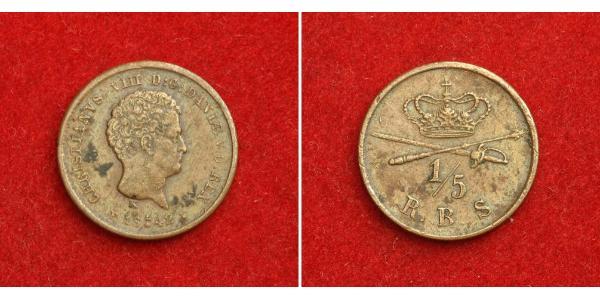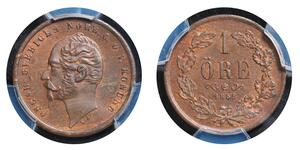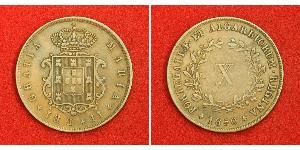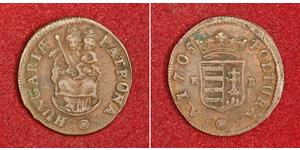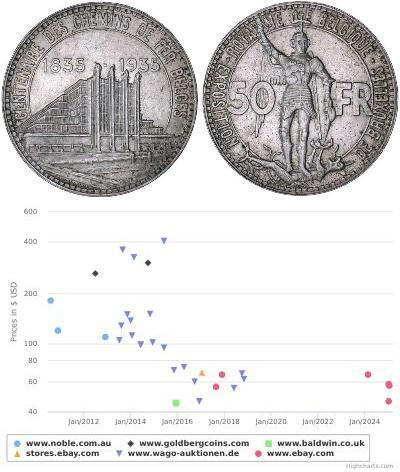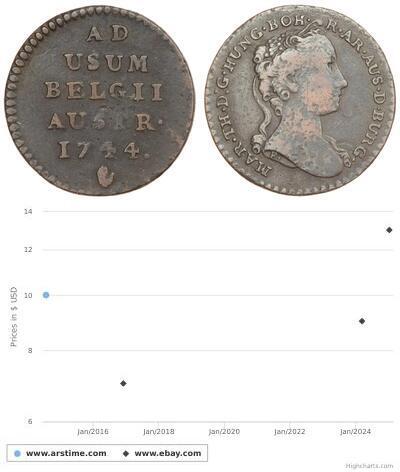(售价 $6.0)
1842, Denmark, Christian VIII. Copper 1/5 Rigsbankskilling Coin. VF
Condition: VF
Mint year: 1842
Mint Place: Altona
References: KM-724.
Material: Copper
Diameter: 15.1mm
Weight: 1.58gm
Obverse: Head of Christian VIII right. Initial (K) below bust.
Legend: CHRISTIANVS VIII D: G DANIAE V: G: REX / F 18 (cross-topped orb) 42 T
Reverse: Crown above crossed scepter and sword. Value (1/5) and denomination (R.B.S) below.
Christian VIII (Christian Frederik) (18 September 1786 – 20 January 1848), king of Denmark 1839–48 and, as Christian Frederick, of Norway 1814, eldest son of Hereditary Prince Frederick of Denmark and Norway and Sophia Frederica of Mecklenburg-Schwerin, was born in 1786 at Christiansborg Palace in Copenhagen. His paternal grandparents were the late king Frederick V of Denmark and his second wife Juliana Maria of Brunswick-Wolfenbüttel.
He inherited the talents of his highly gifted mother, and his amiability and handsome features are said to have made him very popular in Copenhagen.
His unfortunate first marriage at Ludwigslust on 21 June 1806 with his cousin Charlotte Frederica of Mecklenburg-Schwerin (Ludwigslust, 4 December 1784 – Rome, 13 July 1840) was dissolved by divorce in 1810. She was a daughter of Friedrich Franz I, Grand Duke of Mecklenburg-Schwerin and Princess Louise of Saxe-Gotha-Altenburg. His only surviving son from this marriage would become Frederick VII of Denmark. His first born son was Christian Frederik, who was born and died at Schloss Plön on 8 April 1807.
In May 1813, being the then heir presumptive of Denmark-Norway, he was sent as stattholder (the Danish King's highest representative in overseas territories) to Norway to promote the loyalty of the Norwegians to the dynasty, which had been very rudely shaken by the disastrous results of Frederick VI's adhesion to the falling fortunes of Napoleon I of France. He did all he could personally to strengthen the bonds between the Norwegians and the royal house of Denmark. Though his endeavours were opposed by the so-called Swedish party, which desired a dynastic union with Sweden, he placed himself at the head of the Norwegian party of independence after the Treaty of Kiel had forced the king to cede Norway to the king of Sweden. He was elected Regent of Norway by an assembly of notables on 16 February 1814.
See article on Norway in 1814
This election was confirmed by the Norwegian Constituent Assembly convoked at Eidsvoll on 10 April, and on 17 May the constitution was signed and Christian was unanimously elected king of Norway, under the name Christian Frederick.
Christian next attempted to interest the great powers in Norway's cause, but without success. On being pressed by the commissioners of the allied powers to bring about a union between Norway and Sweden in accordance with the terms of the treaty of Kiel, and then return to Denmark, he replied that, as a constitutional king, he could do nothing without the consent of the parliament (Storting), which would not be convoked until a suspension of hostilities on the part of Sweden.
Sweden refused Christian's conditions and a short campaign ensued, in which the Norwegian army was defeated by the forces of the Swedish crown prince Charles John. The brief war was finally concluded by the Convention of Moss on 14 August 1814. According to this treaty, king Christian Frederick transferred the executive power to the Storting, and then abdicated and returned to Denmark. The Storting in its turn adopted the constitutional amendments necessary to allow for a personal union with Sweden, and on 4 November elected Charles XIII of Sweden as the new king of Norway.

